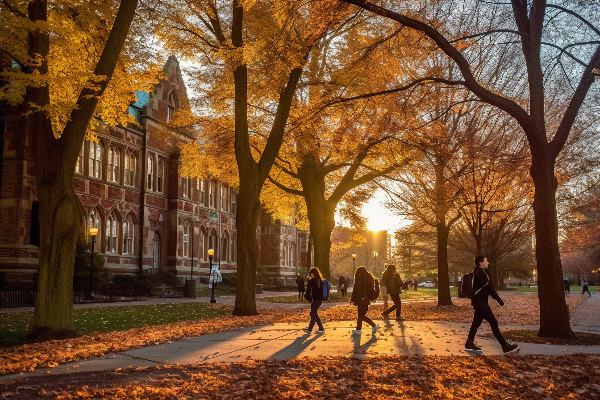Published on
Reimagining Higher Education: Addressing the Needs of Generation Z

Conversations about Generation Z college students often describe them as uninterested, challenging, unable or unwilling to read or write, and not very resilient. Recent pieces in The Chronicle of Higher Education and a spate of LinkedIn comments have only added to this narrative. One cannot help but walk away believing that the kids aren’t alright, or worse, a problem in need of fixing. This viewpoint, however, is at best a gross simplification, since it lays the entire burden on students while ignoring the shortcomings of the systems and structures they must negotiate—systems and structures that regularly fail to reflect or respond to their needs and circumstances.
It’s worth noting that young people have long been a cause of anxiety for older generations. Aristotle stated, “[Young people] are high-minded because they have not yet been humbled by life or experienced the force of circumstances… They believe they know everything and are always certain about it.” While Aristotle’s wry assessment might reflect some truth, it does not absolve higher education of the responsibility to meet students where they are. Rather than wringing our hands over their perceived flaws, we should use their difficulties as a chance to create systems that meet their hopes and expectations.
In my humble opinion, it’s not a student trust issue but higher education’s inability or reluctance to adapt to its students’ evolving needs. I believe that increasing costs, rigid structures and unclear returns on investment (ROI) are contributing to student disengagement. To answer these concerns, higher education must rethink its strategy, emphasizing relevance, affordability and meaningful engagement with students.
Understanding Generation Z
For the uninitiated, Generation Z was born between 1997 and 2012, growing up in a society marked by rapid technological advancements, economic uncertainties and sociological shifts. While many observers are quick to critique them, in all fairness, they have lived through the COVID-19 epidemic, record mass shootings and are deeply concerned about climate change. Many students joined higher education shortly after the Great Recession, facing dual difficulties of rising tuition and fees and growing student debt. As a result, Generation Z prioritizes affordability, flexibility and clear outcomes when evaluating higher education. They are pragmatic and technologically savvy, and they seek an education that is relevant to their career goals. However, most of higher education remains grounded in paradigms created for an earlier era, prompting many students to doubt the relevance and accessibility of traditional academic paths.
Outdated Practices in Higher Education
Higher education is known for its many traditions, but a number of our legacy structures and policies do not meet the needs of today’s learners. For example, the time-based credit hour system sets strict timelines that disadvantage students who must balance employment, family and school, making a system designed to assess learning into a barrier to achievement. Furthermore, rising tuition rates, persistent underemployment and static graduation rates compound these concerns, leading many to question the financial viability of earning a degree, even though a four-year degree remains the surest path to economic stability.
Furthermore, schools frequently struggle to align curricula with workforce expectations, failing to provide the clear pathways to employment that students and families increasingly require. Traditional engagement tactics, which emphasize in-person interactions and on-campus activities, overlook students who thrive in digital or hybrid contexts or have competing interests. Most concerning is that more than 40% of students still do not complete their studies, leaving around 40 million Americans with some college but no certification.
A New Approach to Meeting Student Needs
Rather than critiquing Generation Z for failing to conform to outdated and inflexible systems, higher education would be wise to adapt to meet these discerning learners’ needs. Doing so involves rethinking fundamental aspects of the system, including affordability, accessibility, career preparation, and adopting pedagogical approaches that resonate with modern learners.
Affordability and Value Transparency
Institutions must take bold steps to address cost concerns. Offering options like microcredentials, stackable degrees and pay-as-you-go models can help students manage costs while making the value of their education more transparent. Moreover, clear communication about the ROI of various programs is essential to rebuilding trust with students and families.
Flexible Learning Pathways
Students need options that fit their lives. Hybrid programs, accelerated pathways and competency-based education, such as the model at Western Governors University (WGU), allow students to progress at their own pace, focusing on demonstrated mastery rather than time spent in a classroom. These approaches provide flexibility and cost effectiveness while ensuring students graduate with skills they can immediately apply to their careers.
Career Integration
Institutions must align curricula more closely with workforce needs by embedding career development into academic programs, fostering employer partnerships and prioritizing both technical and evergreen skills development.
Championing the Liberal Arts
As a liberal arts graduate, I deeply value the broad intellectual foundation this education provides. The liberal arts foster critical thinking, creativity and adaptability—skills essential for navigating a rapidly changing world. However, institutions must do a better job of articulating the aims of liberal education and operationalizing its outcomes in terms that students, employers and families can clearly understand. Concrete outcomes like problem solving, ethical reasoning and communication skills must be highlighted as practical and valuable across careers and citizenship. There is great work happening at my own institution, the University of Montana, as well as the University of Minnesota on this particular front.
Innovative Pedagogical Strategies
To engage Generation Z effectively, institutions should adopt active, experiential and interdisciplinary learning models. Approaches like project-based learning, flipped classrooms, gamification and peer collaboration resonate with students’ preferences for hands-on, relevant education.
Prioritizing Student Well-Being
Generation Z has been vocal about the importance of mental health and holistic well-being. Institutions must invest in robust wellness programming, mental health resources and supportive communities to create environments where students can thrive both academically and personally.
Moving Forward
I admit that my advocacy can be unvarnished. I am also aware that I risk being accused of piling on or accidentally providing fodder for naysayers. My higher education peers may view my call for reform as attacking the very institution I aim to enhance, accusing me of being a useful idiot. However, remaining silent about higher education’s flaws would be a betrayal of the students I claim to serve. It is because I believe so strongly in education’s transformative power that I feel driven to question our structures and policies and demand better for learners.
If we truly believe in higher education as a public force for good, we must constantly endeavor to improve it, even if it requires uncomfortable self-reflection. I am convinced that advocating for change is an expression of dedication to the principles and values that initially brought many of us to higher education, rather than a sign of treachery. It acknowledges that our job is not complete and that the way forward is to embrace change rather than oppose it.
Higher education has a unique opportunity—and obligation—to adapt to the demands of all students today, not just Generation Z. Meeting these students where they are takes equal parts bravery, inventiveness and a willingness to forsake ineffective frameworks in favor of truly disruptive innovation. Institutions can keep higher education a socially transformational force by making it affordable, flexible and focused on clear outcomes and engagement.



